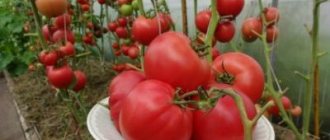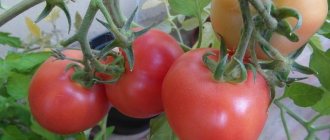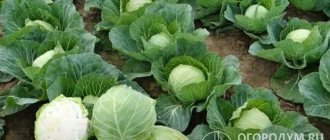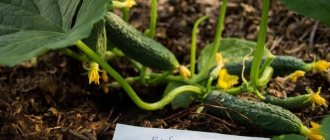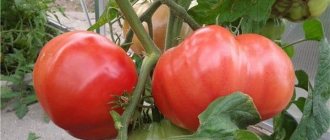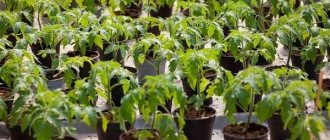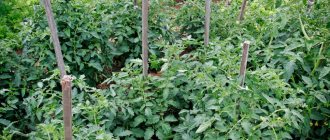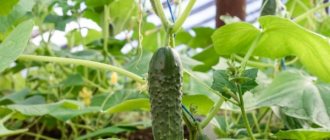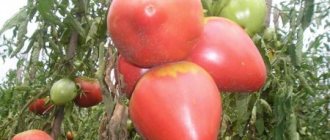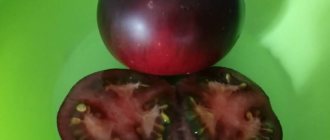Vegetable growing » Tomatoes
0
1651
Article rating
Kira Stoletova
Among the huge variety of tomato varieties, one stands out, which has deservedly received the status of one of the most delicious tomatoes grown in garden beds throughout the country. Tomato Grandmother's Gift must be grown at least once on your own plot in order to understand why gardeners speak so well of it.
Characteristics of tomatoes variety Babushkin Podarok
This variety was bred relatively recently and combines all the good qualities of its parent varieties. Once having tasted Babushkin Podarok tomatoes, more than one summer resident will not resist the temptation to grow these red-sided vegetables in their garden.
Tomato Grandmother's Gift: description of the variety
| Variety name | Grandma's gift |
| general description | Late-ripening, tall, indeterminate variety of tomatoes for greenhouses |
| Originator | LLC "Research Institute of Vegetable Growing of Protected Soil" and LLC "Agrosemgavrish" |
| Ripening period | 120-125 days |
| Form | The fruits are flat-round, large, smooth and slightly ribbed at the stalk. |
| Color | The color of ripe fruits is red |
| Average weight of tomatoes | 180-220 grams |
| Application | Fresh, for preservation in crushed form, for processing into juice and paste |
| Productivity of the variety | 6 kilograms per bush |
| Features of cultivation | Sowing seeds for seedlings 60-65 days before planting, up to 4 plants per 1 sq.m. |
| Disease resistance | resistant to cladosporiosis, fusarium, tobacco mosaic virus |
Grandma's Gift tomatoes are a first generation hybrid. Seeds from hybrid fruits are not intended for planting next year. The plant is indeterminate, tall, 1.5-2 m high .
You can read about determinate, semi-determinate and super-determinate varieties here. The type of bush is not standard. The stem is strong, thick, pubescent, has many leaves, several branches with 6-7 fruits. The rhizome corresponds to all non-standard nightshades - powerful, well branched in all directions.
The leaf is large, dark green, typical “tomato”, wrinkled, with a slight edge. The inflorescence is simple, placed above the 7th leaf for the first time, then every subsequent 2 leaves.
The peduncle is articulated and is well attached to the fruit. According to the type of ripening - late ripening, fruits begin to form 120 - 125 days after germination . Resistant to the main tomato diseases - late blight, powdery mildew, mosaic, cladosporiosis, fusarium. Read about varieties that have the same quality as disease resistance in this article.
Intended for cultivation only in greenhouse conditions, in greenhouses, not suitable for open ground.
Read on our website all about polycarbonate greenhouses - summer and heated winter ones, about do-it-yourself greenhouses and glass structures.
We bring to your attention up-to-date information about tomatoes presented on our website. Learn all about the difference between determinate and indeterminate tomatoes.
Tomato care
After the seedlings have taken root, surface loosening of the soil and the first hilling are carried out. Loosening is carried out as a crust forms on the surface of the earth, hilling - 3-4 times per season. These measures allow the roots to breathe and improve the delivery of nutrients.
At the same time, perform the first tying of the bush to a support (trellis, peg). Carry out the garter 2-3 times during the season.
Important! Hilling should be carried out after rain or after watering - damp soil will accelerate the growth of new roots.
Watering is carried out at the root, adding 0.7-0.9 liters to each bush. The best time to water is early morning or evening. During the flowering period of the first and second clusters, watering is required.
At high outside temperatures, the greenhouse should be ventilated so that fresh air circulates - high humidity and heat contribute to the development of late blight.
Once a week you need to remove side shoots that have reached 3-5 cm, leaving a small stump - then a new shoot will not grow in this place.
Feeding tomatoes
10-12 days after planting, carry out the first fertilizing by preparing a mixture: add superphosphate (20g) to 10 liters of mullein solution (1 part manure and 8-9 parts water). Use this volume for 10 bushes.
The next two feedings are carried out at intervals of 2 weeks after loosening or before hilling using mineral fertilizers - add superphosphate (20g), potassium salt (15g) and ammonium nitrate (10g) per 1 m².
Signs of nutritional deficiencies
By changes in the appearance of a tomato bush, one can judge the lack of a particular substance in the soil:
- lack of nitrogen - the color of leaves and fruits changes, the leaves become small, red-blue veins appear on the bottom, and the fruits harden;
- lack of phosphorus - leaves begin to curl inward;
- lack of potassium is manifested by leaf curl;
- the appearance of yellow spots on young leaves, a change in the color of old leaves to dark green indicates a lack of calcium;
- fragility and brittleness of the stems, first pale green leaves, and then their yellowing or redness indicate a lack of sulfur;
- Brown spots on the fruit indicate a lack of boron;
- Tomato bushes stop growing, young leaves are affected by chlorosis due to iron deficiency.
Characteristics
The Grandmother's Gift tomato has a rich sweet taste with notes of sourness and a wonderful aroma. The pulp is tender and juicy. The fruits are slightly ribbed, the size of a fist, weighing 180-200, sometimes up to 300 g, and have a rounded, flattened shape . The skin is smooth, dense, thin. The color of an unripe fruit is pale green with darkening at the stalk, while that of a ripe fruit is pink or red. The seeds are distributed evenly across 8 chambers; there is little dry matter.
The table below provides comparison data on fruit weight for other tomato varieties:
| Variety name | Fruit weight |
| Grandma's gift | 180-220 grams |
| Fat Jack | 240-320 grams |
| Premier | 120-180 grams |
| Broody | 90-150 grams |
| Polbig | 100-130 grams |
| Brawler | 100-180 grams |
| Black bunch | 50-70 grams |
| Grapefruit | 600-1000 grams |
| Kostroma | 85-145 grams |
| American ribbed | 300-600 grams |
| The president | 250-300 grams |
Storage is satisfactory if done in a dry, dark place. Handles transportation with dignity.
The hybrid was bred in the Russian Federation (originators: Scientific Research Institute of Vegetable Growing of Protected Soil LLC and Agrosemgavrish LLC). Registered in the State Register of the Russian Federation for cultivation in unheated greenhouses in 2010. It can be grown throughout the Russian Federation, in greenhouses.
They note the exquisite taste of tomatoes and juiciness. Suitable for consumption both fresh and after heat treatment . Suitable for preservation in crushed form. Good for processing into tomato paste and juice.
With timely treatments, the yield can reach 6 kg per bush or about 10 kg per 1 sq. m.
You can see the yield of other varieties in the table:
| Variety name | Productivity |
| Grandma's gift | 6 kg per bush |
| Olya-la | 20-22 kg per square meter |
| Nastenka | 10-12 kg per square meter |
| King of Kings | 5 kg per bush |
| Banana red | 3 kg per bush |
| Gulliver | 7 kg per bush |
| Brown sugar | 6-7 kg per square meter |
| Lady Shady | 7.5 kg per square meter |
| Rocket | 6.5 kg per square meter |
| Pink Lady | 25 kg per square meter |
Harvesting tomatoes
To ripen the formed fruits, buds and flowers are removed three weeks before complete harvesting. Harvesting should be done in stages, collecting uneven fruits first. For further ripening and storage, healthy brown fruits are collected.
It is recommended to harvest tomatoes before the air temperature drops below 8° - at low temperatures the fruits may become sick.
Advantages and disadvantages
Hybrids are bred with the exception of disadvantages; the only disadvantages that can be identified are a long growing season and the impossibility of growing in open ground.
Advantages:
- large fruits;
- taste qualities;
- high yield;
- heat resistance;
- disease resistance;
- peculiarities.
A distinctive feature is excellent drought resistance.
Read about tomatoes that not only produce abundant harvests, but also successfully resist nightshade diseases here.
Pros and cons of the variety
This variety of tomatoes has become popular and gained the trust of gardeners due to a number of advantages:
- It is low maintenance;
- High yields;
- Resistance to low temperatures;
- Resistance to various kinds of diseases;
- Delicious tomatoes;
- The versatility of fruit use.
Despite most of the positive aspects of the variety, there are still some disadvantages:
- Fruits may crack;
- A small number of seeds, which makes it difficult to prepare seed;
- Yellow spots on the stalk due to insufficient nutrition.
Judging by the demand among gardeners and the majority of positive reviews, the advantages of the Babushkino variety of tomatoes cover all its disadvantages. Yes, and some disadvantages can be eliminated if you adhere to the rules of care.
Features of cultivation
Due to the late ripening, the Grandmother's Gift tomato variety must be sown as seedlings in mid-February in a common container to a depth of 2 cm, in rows with a distance of 2 cm between them.
Immediately after planting, cover with polyethylene and create the necessary humidity to improve germination conditions. You can use growth stimulants and mini-greenhouses for ease of growing. After emergence of shoots, open. Due to the lack of sunlight in winter, an additional light source is needed . Picking is carried out when a full leaf is formed.
At the end of April you can plant it in a permanent place. The soil must be heated to 25 degrees and disinfected. The planting pattern is checkerboard, the distance between plants is 40 cm. Plants should be immediately tied to individual supports or trellises with synthetic fabric.
Watering - moderate, at the root. For irrigation, use warm water, preferably rain, settled water . Feeding according to schedule (once every 1.5 weeks). Loosening is welcome. Weeding as necessary.
Read more about fertilizing tomatoes and the correct use of various types of fertilizers: organic, iodine, hydrogen peroxide, ammonia, yeast, boric acid.
Initial pinching, to form a bush with 1 stem. The lower leaves are removed. At the end of fruit formation, it is necessary to remove the growing points (“pinching”). Next, wait for the fruit to ripen and enjoy the taste. If necessary, mulching can be used.
Transplanting seedlings into a greenhouse or open ground
Southern, southwestern and southeastern areas are suitable for planting tomatoes. An area along a southern fence or wall would also be suitable.
Tomatoes are favorable to zucchini, cucumbers, cabbage, onions that grew before them, but it is not recommended to plant them after peppers, potatoes, eggplants and physalis - they have common pathogens. Planting can be repeated after three years.
You need to start preparing the soil for tomatoes in the fall. To do this, the area is dug up, organic matter (10 liters per 1 m²) and superphosphate (40-60 g per 1 m²) are added. If the soil is acidic, then you can add 0.5-0.9 kg of lime per 1 m².
In the spring, it is enough to loosen the soil, adding superphosphate (30-40g) and potash fertilizers (25-30g) for every 1 m². Immediately before planting, add potassium fertilizer (20g) and nitrogen fertilizer (30-40g) per 1 m² to the soil.
Transplanting seedlings:
- can be replanted in soil heated to 12°-15° in the absence of a threat of frost (the ground warms up well under a black film, roofing material);
- Planting should be carried out in furrows or holes at a distance of 30-40 cm between bushes and row spacing of 30-50 cm;
- Fill the holes well with water and wait for the moisture to be absorbed;
- It is recommended to remove the lower leaves from the bush, deepen the trunk by a third, and deepen the tall trunk by half, sloping it to the northwest;
- Sprinkle the roots in a straightened form with earth, lightly crush it, pour with warm water;
- At the same time, you need to install pegs for tying, so as not to damage the roots later;
- During 7-10 days of planting, do not water, loosen or hill up, giving them the opportunity to take root well.
For early planting of seedlings, you can use steam beds: a trench 60 cm wide and 20 cm deep is filled with heated manure (5 cm) and covered with earth (15 cm).
On a note! Planting on such ridges is carried out 20 days earlier.
Diseases and pests
The hybrid is resistant to many diseases of tomatoes grown in a greenhouse, but prevention will not hurt. Read about ways to do this here. We also offer interesting information about varieties that are not susceptible to late blight.
For pests (aphids, mole crickets, cutworms), spraying with microbiological substances of general action is necessary.
Grandma's gift will delight you with juicy fruits after the early ripening varieties have finished bearing fruit. And to continue the topic and to expand it, let me offer you articles on how to get a high yield of tomatoes in open ground, how to do this in a greenhouse throughout the year, and what subtleties of growing early varieties you should know.
Useful video
Watch the video: tomatoes Grandma's gift
In the table below you will find links to tomato varieties with different ripening periods:
| Early ripening | Mid-late | Mid-early |
| Pink fleshy | Yellow banana | Pink King F1 |
| Ob domes | Titanium | Babushkin |
| King of the Early | Slot F1 | Cardinal |
| Red Dome | gold fish | Siberian miracle |
| Soyuz 8 | Raspberry miracle | Bear Paw |
| Red icicle | De Barao red | Bells of Russia |
| Honey cream | De Barao black | Lev Tolstoy |
